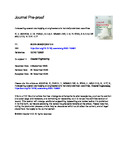Forecasting coastal overtopping at engineered and naturally defended coastlines
| dc.contributor.author | Stokes, C | |
| dc.contributor.author | Poate, Tim | |
| dc.contributor.author | Masselink, Gerd | |
| dc.contributor.author | King, E | |
| dc.contributor.author | Saulter, A | |
| dc.contributor.author | Ely, N | |
| dc.date.accessioned | 2020-12-14T21:34:12Z | |
| dc.date.issued | 2021-03 | |
| dc.identifier.issn | 0378-3839 | |
| dc.identifier.issn | 1872-7379 | |
| dc.identifier.other | 103827 | |
| dc.identifier.uri | http://hdl.handle.net/10026.1/16745 | |
| dc.description.abstract |
As sea level rises and development of the coastal zone continues, coastal flooding poses an increasing risk to coastal communities. Wave runup can contribute many meters to the vertical reach of the sea, especially on steep gravel beaches, and wave overtopping is a key contributor to coastal flooding along coastlines exposed to energetic wave conditions. However, operational forecasting of wave overtopping has rarely been attempted due to the need for high-resolution inshore water levels and wave conditions, up-to-date coastal profile and sea defence information, and availability of models or formulae that can robustly predict overtopping for a range of coastal profile types. Here, we have developed and tested an efficient forecasting system for providing operational warnings up to three days in advance for the entire 1000 km coastline of southwest England, called SWEEP-OWWL, which is capable of predicting wave runup elevation and overtopping volumes along the energetic and macrotidal coastline, featuring embayed, sandy, gravel, and engineered regions. Existing flood warning systems have used the process-based hydrodynamic model XBeach, but due to the computational cost, have resorted to populating look-up tables using off-line simulations and only a single realisation of the coastal bathymetry. Instead, SWEEP-OWWL runs in ‘real-time’ using a computationally efficient suite of empirical shoaling, breaking, runup, and overtopping equations at 184 coastal profiles, forced with hydrodynamic information from a regional 1-km spectral wave and hydrodynamic model. Importantly, the forecast system can be updated with the latest coastal profile data with no extra computational cost, which is shown to improve the accuracy of predicted overtopping rate by an order of magnitude in some cases. Compared to visual observations of flooding events from live streaming webcams around the southwest, the system correctly predicted the presence or absence of wave overtopping with 97% accuracy and showed skill in differentiating between low and high hazard events. Reliable forecasts of wave overtopping could considerably enhance a coastal community's ability to prepare and mitigate against the risk to life, property, and infrastructure during coastal flooding events, and the developed system shows that this can be achieved using a single desktop PC for entire regions featuring both natural and man-made sea defences. | |
| dc.format.extent | 0-0 | |
| dc.language | en | |
| dc.language.iso | en | |
| dc.publisher | Elsevier | |
| dc.subject | wave overtopping | |
| dc.subject | Coastal flooding | |
| dc.subject | Sea defence | |
| dc.subject | Coastal hazards | |
| dc.subject | Wave Runup | |
| dc.subject | Sea level rise | |
| dc.subject | Forecasting | |
| dc.title | Forecasting coastal overtopping at engineered and naturally defended coastlines | |
| dc.type | journal-article | |
| dc.type | Journal Article | |
| plymouth.author-url | https://www.webofscience.com/api/gateway?GWVersion=2&SrcApp=PARTNER_APP&SrcAuth=LinksAMR&KeyUT=WOS:000613935600001&DestLinkType=FullRecord&DestApp=ALL_WOS&UsrCustomerID=11bb513d99f797142bcfeffcc58ea008 | |
| plymouth.issue | 0 | |
| plymouth.volume | 164 | |
| plymouth.publication-status | Published | |
| plymouth.journal | Coastal Engineering | |
| dc.identifier.doi | 10.1016/j.coastaleng.2020.103827 | |
| plymouth.organisational-group | /Plymouth | |
| plymouth.organisational-group | /Plymouth/Faculty of Science and Engineering | |
| plymouth.organisational-group | /Plymouth/Faculty of Science and Engineering/School of Biological and Marine Sciences | |
| plymouth.organisational-group | /Plymouth/REF 2021 Researchers by UoA | |
| plymouth.organisational-group | /Plymouth/REF 2021 Researchers by UoA/UoA07 Earth Systems and Environmental Sciences | |
| plymouth.organisational-group | /Plymouth/Research Groups | |
| plymouth.organisational-group | /Plymouth/Research Groups/Marine Institute | |
| plymouth.organisational-group | /Plymouth/Users by role | |
| plymouth.organisational-group | /Plymouth/Users by role/Academics | |
| plymouth.organisational-group | /Plymouth/Users by role/Researchers in ResearchFish submission | |
| dcterms.dateAccepted | 2020-11-29 | |
| dc.rights.embargodate | 2020-12-16 | |
| dc.identifier.eissn | 1872-7379 | |
| dc.rights.embargoperiod | Not known | |
| rioxxterms.versionofrecord | 10.1016/j.coastaleng.2020.103827 | |
| rioxxterms.licenseref.uri | http://www.rioxx.net/licenses/all-rights-reserved | |
| rioxxterms.licenseref.startdate | 2021-03 | |
| rioxxterms.type | Journal Article/Review | |
| plymouth.funder | Physical and biological dynamic coastal processes and their role in coastal recovery (BLUE-coast)::NERC | |
| plymouth.funder | Physical and biological dynamic coastal processes and their role in coastal recovery (BLUE-coast)::NERC | |
| plymouth.funder | Physical and biological dynamic coastal processes and their role in coastal recovery (BLUE-coast)::NERC |


